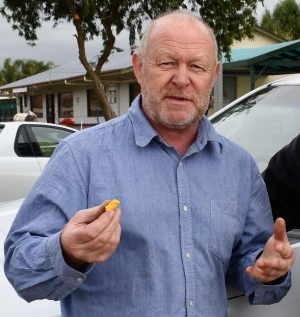Hot tips for compliant and effective spraying
Hot tips for compliant and effective spraying
Author: GRDC Adelaide office | Date: 19 Feb 2020

Grain growers undertaking summer weed control are reminded of the requirement to comply with changes to 2,4-D label instructions which were introduced in October 2018.
Leading spray application specialist Jorg Kitt says changes to 2,4-D label instructions have implications for spray quality, efficacy and adjuvant use.
Dr Kitt, who has led Grains Research and Development Corporation (GRDC) effective spray application workshops, is reminding growers and spray operators of the changed label instructions, to ensure that summer spraying programs remain both compliant and effective.
“2,4-D is a major contributor to drift damage in sensitive crops, and the new label requirement are designed to minimise these drift incidents,” he said.
“In terms of spray quality, it is now mandatory to apply 2,4-D amine and ester products with a droplet size no smaller than very coarse.
“In the period from the October 1 to April 15, when most 2,4-D sensitive crops are growing, the Australian Pesticides and Veterinary Medicines Authority (APVMA) advises applying 2,4-D with a spray quality not smaller than extremely coarse.”
These new instructions have consequences for nozzle selection and application decisions.
“As a starting point, to fulfil the new requirements, growers and spray operators should look at high-pressure air-induction nozzles which should be run on pressures at or above ‘four bar’,” Dr Kitt says.
“However, even these nozzles will generally not be able to meet the advisory requirements to spray with an extremely or ultra coarse spray quality from October to April, unless the pressure is dropped so low that droplet production may be compromised. There are only a few nozzle types that can produce droplets that size.”
Dr Kitt says the new regulations are mainly designed to avoid off-target drift.
“They are unlikely to reduce efficacy on larger summer weeds such as melons or larger marshmallows. However, they are likely to reduce efficacy on smaller weeds such as fleabane seedlings, especially when stubbles interfere with the spray pattern.”
Dr Kitt has provided the following rules of thumb to improve efficacy:
The spray medium – use of adjuvants. This is an often-overlooked aspect that can have a profound impact on spray quality and spray pattern. The spray medium interacts with different nozzle types in different ways:
- TTI – The Turbojet TTI is the most commonly used nozzle type in Australia to produce an extremely coarse spray quality. It is a very robust nozzle in reducing the amount of driftable fine sprays and can be used over a wide range of pressures. The principle of producing the spray fan is different to most other nozzles. Once the spray solution has left the output orifice it is thrown against an anvil-type plastic part that directs the spray fan in an angle downwards. The spray sheet is basically broken up before the liquid leaves the nozzle. This spray sheet is the part where adjuvants have the greatest effect. As a result, a TTI nozzle is barely affected by adjuvants.
- Other nozzles – With the introduction of new regulations in Australia and other parts of the world, other nozzle manufacturers have released other versions of nozzles capable of producing an extremely coarse spray quality, for example the agrotop TurboDrop® XL-D. These nozzles generally have a conventional flat fan that appears uninterrupted underneath the output orifice of the nozzle. That means they produce slightly more driftable fine sprays compared to a TTI nozzle. However, this also means they can be manipulated with adjuvants to reduce the amount of driftable fine sprays and, at the same time, optimise the spray pattern on the ground. On the other hand, they can also be counterproductive by increasing the amount of driftable fine sprays. The choice of the right adjuvant is important.
Increase in water rate. If the nozzle produces fewer and bigger droplets, the likelihood of hitting small targets is compromised. More water means generally more droplets. Applicators should change their practice to use 100 litres/hectare if they are chasing small weeds with an extremely coarse spray quality.
Decrease in speed. If there are stubbles present, a sprayer needs time to penetrate the stubble load. Slower speeds increase the likelihood of hitting relatively hidden targets. This provides additional benefits such as less dust production and less bounce of the boom which could be used to lower the boom height. Speeds of 12-16 kilometres/hour are optimal, with a maximum of 18 km/h.
Increase in product rate. This is not a popular option but generally this is the number one measure that has consistently increased efficacy in most trial work. After all, the most expensive spray is the one that has not worked. It is critical to not exceed the maximum label rate.
Dr Kitt advises growers who are unsure about which nozzles to select (to meet new 2,4-D requirements) to seek expert advice from their agronomist or machinery dealer, attend a GRDC spray application workshop or seek out the extensive resources available on the GRDC’s Spray Drift resource hub.
“While the new 2,4-D instructions can reduce the efficiency of spray operations, they are a positive move in protecting other agricultural crops, ensuring good relationships across sectors and enhancing our reputation as safe and compliant users of agricultural chemicals,” Dr Kitt says.
“Under the changes, buffer areas came down significantly to more manageable distances and, more importantly, drift incidences are likely to decrease which is vital to secure a future of 2,4-D use in Australia.”
Contact Details
More Information
Jorg Kitt, Kitt Consulting
0429 939 403
jorgkitt@gmail.com
Contact
GRDC Adelaide office
(08) 8198 8400
media@grdc.com.au
GRDC Project Code: BWD1803-005SAX,
